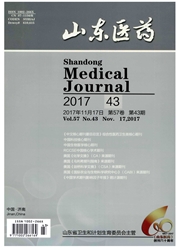

 中文摘要:
中文摘要:
目的 探讨成人烟雾病(MMD)缺血性事件或出血性事件的危险因素.方法 选取68例成人MMD患者,发生缺血性事件44例(缺血组),发生出血性事件24例(出血组).缺血组中23例(52.27%)为TIA,前循环受累19例,后循环受累4例;21例(47.73%)为脑梗死,大脑半球受累13例,基底节受累10例,胼胝体受累2例,间脑与脑干受累各1例.出血组中16例(66.67%)为脑出血,单纯脑实质受累6例,单纯脑室受累6例,脑实质合并脑室受累4例;5例为蛛网膜下腔出血;3例为脑出血合并蛛网膜下腔出血.两组29例行血管重建术,患者术后3~17个月复查,显示均已建立颈外动脉至颈内动脉交通支.对可能影响MMD患者发生缺血性事件或出血性事件的相关因素进行多因素非条件Logistic回归分析.结果 缺血组与出血组入院时NIHSS评分分别为(5.230±3.072)、(8.790 ±3.811)分,住院期间最高NIHSS评分分别为(5.550±3.302)、(9.880±5.007)分,出院时NIHSS评分分别为(3.500±3.386)、(3.290±4.438)分,两组入院及住院期间最高NIHSS评分比较,P均<0.01.单因素分析发现,出血组有反复头痛头晕史、嗜烟、合并脑动脉瘤比例明显高于缺血组(P均<0.05).多因素非条件Logistic回归分析结果显示合并脑动脉瘤是成人MMD患者发生出血性事件的独立危险因素.结论 缺血是MMD患者发生出血的根本原因,缺血性事件主要是前循环TIA及大脑半球、基底节脑梗死,出血性事件主要是脑出血,出血患者发病时症状重于缺血患者;合并脑动脉瘤是成人MMD患者发生出血性事件的独立危险因素.
 英文摘要:
英文摘要:
Objective To investigate the risk factors of ischemic and hemorrhagic events for adult patients with moyamoya disease (MMD).Methods We chose 68 adult MMD patients,who were composed of 44 ischemic patients (Ischemia group) and 24 hemorrhagic patients (Hemorrhage group).Ischemia group comprised 23 TIA patients (19 cases of anterior circulation involvemem and 4 of posterior circulation) and 21 patients with cerebral infarction (13 cases of cerebral hemisphere involvement,10 of basal ganglia,2 of corpus callosum,1 of diencephalon and 1 of brainstem).Hemorrhage group included 16 patients with intracerebral hemorrhage (6 cases of cerebral parenchyma involvement,6 of ventricle,4 of both cerebral parenchyma and ventricle involvement),5 patients with subarachnoid hemorrhage and 3 patients with intracerebral as well as subarachnoid hemorrhage.Twenty-nine patients received revascularization therapy and the communicating branch was constructed from external carotid artery to internal carotid artery as examined 3-17 months later.We compared the differences in risk factors between ischemia group and hemorrhage group by multi-factor unconditioned Logistic regression analysis.Results Regarding ischemia group,admission NIHSS score was 5.230 ± 3.072,the highest score was 5.550 ± 3.302,and 3.500 ± 3.386 when leaving hospital.For hemorrhage group,the corresponding scores were 8.790 ± 3.811,9.880 ± 5.007 and 3.290 ± 4.438.Significant differences were found in admission scores and the highest scores of these two groups (all P < 0.01).Univariate analysis showed that the proportion of patients with repeated episodes of headache and dizziness,smoking addiction and cerebral aneurysms was lower in ischemia group than that of hemorrhage group (all P < 0.05).And multi-factor unconditioned Logistic regression analysis showed that cerebral aneurysm was the independent risk factor for an hemorrhagic event.Conclusions Cerebral ischemia is the basic reason of hemorrhagic event.Ischemia group mainly suffer
 同期刊论文项目
同期刊论文项目
 同项目期刊论文
同项目期刊论文
 The level of circulating endothelial progenitor cells may be associated with the occurrence and recu
The level of circulating endothelial progenitor cells may be associated with the occurrence and recu Effects of atorvastatin on chronic subdural hematoma: A preliminary report from three medical center
Effects of atorvastatin on chronic subdural hematoma: A preliminary report from three medical center 期刊信息
期刊信息
